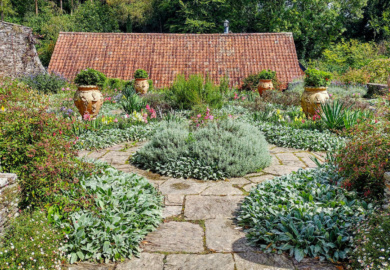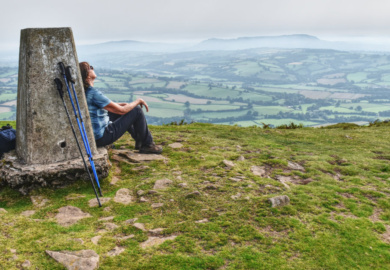There are at least two cracking circular walks from Lynmouth. One is the route to Watersmeet, the other is into the Valley of Rocks, a stunning natural amphitheatre famous for its rock formations and feral goats.

Many routes start from the Lynton end of the Lynton and Lynmouth funicular Cliff Railway, the highest and steepest water-powered railway in the world. We started at Lynmouth because that’s where we’d parked the car, and our map showed a path climbed from the harbour car park through the woods to connect with the South West Coast Path leading to Valley of Rocks. It’s a relatively steep huff and puff climb, but it is handy for doing a circular route that doesn’t involve jumping in the car and finding a parking space in Lynton.
Once on the South West Coast Path, it’s an even(ish) stroll along the rocks to reach the valley. Easy walking to a famous landmark does usually mean there are more people, yet on a warm and sunny day in mid-July it wasn’t exactly what you’d call busy, but it was the week before the school holidays (deliberately chosen). One group of young foreign tourists made up for the lack of other walkers by playing music at full blast, destroying nature’s soundtrack which, given the music they were playing was trashy mediocre Europop rather than anything decent, ruined the drama of scenes of the rugged coast with its rock formations looking like petrified sentinels. At various points we passed viewpoints with telescopes, but the scenery is so immersive they’re not really required. After a kilometre or so on the Coast Path, we emerged at the valley, hidden from view until almost the very last moment.

Valley of Rocks
I’d heard a lot about the Valley of Rocks. When neighbours found out we were hikers, it was the first place many enthused about. I’ve walked a lot of gorgeous looking valleys in many different countries, so expected nice scenery but nothing particularly new. I was wrong. There is something magical and unique about Valley of the Rocks, as if it could be more fictitious creation than a work of nature.
Geologists theorise that the verdant amphitheatre is a dry river bed where the River Lyn once flowed, or that it was formed during the last Ice Age, Whatever, it’s a pretty stunning place, a flat basin surrounded by irregular rock formations with emotive names – Castle Rock, Mother Meldrum’s Cave (named after the witch – or wise woman – in R.D. Blackmore’s classic novel, Lorna Doone), Rugged Jack (possibly a Lynton boy who skipped school so much to wander the valley, he was turned into a rock stack). Once we gained a bit of height, climbing the narrow rocky path to Castle Rock accompanied by a bloody-breasted stonechat, it was easy to imagine there might once have been a spectacular waterfall cascading into the sea where the valley opens into the Bristol Channel.

A flat rock on Castle Rock makes for a fabulous viewing platform to absorb a 360-degree panorama which takes in the entire valley, the coastline, and the channel with its view across to Wales. It’s a good spot to look for the famous feral goats, not a particularly difficult task on the day we were there as many wandered around the green basin, munching at anything they could get their chops around, virtually ignoring curious humans who wandered close. Goats have roamed the Valley of Rocks for at least 3500 years, from a time when it was farmlands. Although feral now, they were originally livestock. The current herd are descended from Northumberland Cheviots introduced in 1976. An attraction they may be, but local love for these refuse bins on four legs is divided, partly the reason there’s a need for a Feral Goat Preservation Society.
The only blight on the valley is the narrow road that dissects it. A convenience for access it may be, but it does scar the natural splendour of the place. Other human-made features include parking, Mother Meldrum’s Café, a shelter with informative mosaics, and The Warren Cricket Ground, established in 1876, whose neat pitch makes for a curious contrast against the wild slopes and crags.
Out of the Valley
In some ways, the route out of Valley of Rocks is better than the way in, for views at least. A path zigzags up the hillside opposite the toilet block, about 350m further along the road from the café. Despite the healthy number of visitors to the valley, we found ourselves alone on this path. The higher we climbed, the better the scenery. Looking west gave a different, possibly better, perspective. Plus, it revealed an intriguing ridge route along Rugged Jack that we didn’t spot from below. The reward for the steepish climb is a bench with stupendous views high above the valley. This path links back up with the South West Coast Path, but we cut off before the ridge to follow another path back through the woods of Hollerdale Hill to drop into Lynton and complete the circuit by following the Poets’ Path which criss-crosses the funicular railway, passing poems and strange little statues before depositing us back in Lynmouth.

Distance: Approx. 5.5km; ascent/descent 500m


